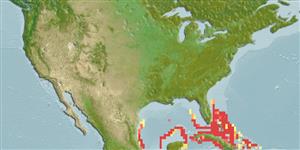Elasmobranchii (sharks and rays) >
Carcharhiniformes (Ground sharks) >
Scyliorhinidae (Cat sharks)
Etymology: Scyliorhinus: Greek, skylla = a kind of shark + Greek, rhinos = nose (Ref. 45335).
Environment / Climate / Range
Ecology
Marine; bathydemersal; depth range 200 - 600 m (Ref. 55584), usually 366 - 550 m (Ref. 244). Deep-water, preferred ?; 30°N - 20°N
Western Central Atlantic: southern Florida (USA), Bahamas, and Cuba.
Size / Weight / Age
Maturity: Lm ? range ? - ? cm
Max length : 32.0 cm TL male/unsexed; (Ref. 244)
Short description
Morphology | Morphometrics
Broad rounded snout. Pale brown back and upper sides transversely marked by series of indistinct darker blotches. Finer markings consist of small oval whitish spots, evenly distributed over the whole back and upper sides (Ref. 6032).
Found on the upper continental slope. Little is known of its biology. Oviparous (Ref. 50449).
Life cycle and mating behavior
Maturity | Reproduction | Spawning | Eggs | Fecundity | Larvae
Oviparous, paired eggs are laid. Embryos feed solely on yolk (Ref. 50449).
Compagno, L.J.V., 1984. FAO Species Catalogue. Vol. 4. Sharks of the world. An annotated and illustrated catalogue of shark species known to date. Part 2 - Carcharhiniformes. FAO Fish. Synop. 125(4/2):251-655. Rome: FAO. (Ref. 244)
IUCN Red List Status (Ref. 115185)
CITES (Ref. 94142)
Not Evaluated
Threat to humans
Harmless
Human uses
Fisheries: of no interest
More information
Age/SizeGrowthLength-weightLength-lengthLength-frequenciesMorphometricsMorphologyLarvaeLarval dynamicsRecruitmentAbundance
ReferencesAquacultureAquaculture profileStrainsGeneticsAllele frequenciesHeritabilityDiseasesProcessingMass conversion
Tools
Special reports
Download XML
Internet sources
